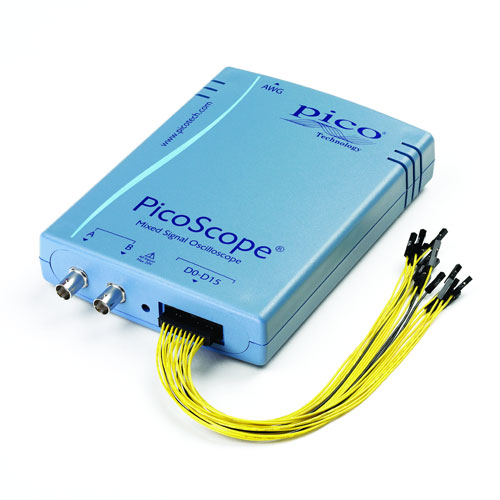The new range of mixed–signal oscilloscopes (MSOs) from Pico Technology combines the deep memory and high performance of the PicoScope 3000 Series with a powerful 16–channel logic analyzer. With a built–in function generator and arbitrary waveform generator also included, these oscilloscopes offer a complete test bench in one compact, USB–powered device.
The new MSOs have 2 analog channels with bandwidths from 60 MHz to 200 MHz, a maximum single–channel sampling rate of 500 MS/s, and 100 MHz digital inputs.
Serial data in I²C, UART/RS232, SPI, CAN bus, LIN and FlexRay formats can be decoded and displayed in binary, decimal or hexadecimal formats. The 16 logic inputs are organized in two banks, each of which has its own adjustable logic threshold to allow testing of mixed-logic designs.
The PicoScope software supplied with the MSOs includes as standard all the oscilloscope and spectrum analyzer functions you would expect, as well as mask limit testing, segmented memory, advanced triggers and the serial decoding mentioned above: features that often cost extra on other manufacturers’ scopes. Other built–in features include persistence displays with fast update rates, math channels, automatic measurements with statistics, and programmable alarms. Updates to the software are free of charge.
The advanced trigger types include pulse width, interval, window, window pulse width, level dropout, window dropout, runt pulse, variable hysteresis, and logic. All triggering is digital, ensuring lower jitter, greater accuracy and higher voltage resolution than the analog triggering found on many competing scopes.
A free Software Development Kit (SDK) allows you to control the new scopes from your own programs. It includes example code in C, C++, Excel and LabVIEW, and can be used with any language that supports C calling conventions. The PicoScope software and SDK are compatible with Microsoft Windows XP, Windows Vista, Windows 7 and Windows 8.
Pico Technology
www.picotech.com


Leave a Reply
You must be logged in to post a comment.